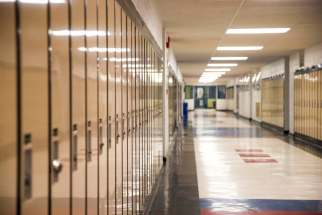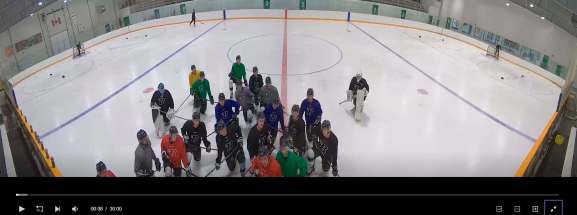Students hearing bells, not alarms No sign officials considering closing schools despite soaring city, provincial test-positivity rates
Read this article for free:
or
Already have an account? Log in here »
To continue reading, please subscribe:
Monthly Digital Subscription
$0 for the first 4 weeks*
- Enjoy unlimited reading on winnipegfreepress.com
- Read the E-Edition, our digital replica newspaper
- Access News Break, our award-winning app
- Play interactive puzzles
*No charge for 4 weeks then price increases to the regular rate of $19.00 plus GST every four weeks. Offer available to new and qualified returning subscribers only. Cancel any time.
Monthly Digital Subscription
$4.75/week*
- Enjoy unlimited reading on winnipegfreepress.com
- Read the E-Edition, our digital replica newspaper
- Access News Break, our award-winning app
- Play interactive puzzles
*Billed as $19 plus GST every four weeks. Cancel any time.
To continue reading, please subscribe:
Add Free Press access to your Brandon Sun subscription for only an additional
$1 for the first 4 weeks*
*Your next subscription payment will increase by $1.00 and you will be charged $16.99 plus GST for four weeks. After four weeks, your payment will increase to $23.99 plus GST every four weeks.
Read unlimited articles for free today:
or
Already have an account? Log in here »
Hey there, time traveller!
This article was published 13/11/2020 (1850 days ago), so information in it may no longer be current.
Winnipeg’s COVID-19 test-positivity rate has far surpassed the mark other North American cities have set to trigger school closures, but local public-health officials insist in-class learning is essential.
On a steady incline in recent weeks, the rate — which is calculated based on tests that come back positive over a five-day period — reached a record high of 12.2 per cent in the Manitoba capital Friday. The provincewide figure is currently 11.6 per cent.
While the percentage is a barometer that needs to be considered in the context of case backlogs and targeted testing, it’s useful in assessing the extent to which community transmission is happening in a city.
“When you have an accelerating test positivity, it indicates that transmission hasn’t reached a plateau,” said Dr. James Blanchard, an epidemiologist and public-health specialist at the University of Manitoba.
That’s one of the reasons Blanchard said policy-makers have picked out test positivity as a “guidepost” in determining whether schools should remain open.
In New York City, families are bracing for a pivot to universal remote learning as early as Monday as the city’s seven-day positivity rate nears three per cent — the threshold local leadership has indicated will trigger closures.
Students in Detroit, where the infection positivity rate is more than five per cent, learned this week remote learning would be the norm into 2021.
Three weeks ago, when Boston’s seven-day rate exceeded five per cent, the public board called off in-class learning.
“The most challenging thing is to decide, when do you see enough signal of acceleration to the point where you say, ‘We need to put the brakes on now?’” Blanchard said.
As chief public health officer Dr. Brent Roussin provided the latest on COVID-19 in Manitoba Friday, he reflected on earlier days in the pandemic — when the total caseload was in single digits and the test-positivity rate suggested there was minimal, if any, community transmission.
Roussin recalled months-old messaging in which officials indicated a test-positivity rate of three per cent would be cause for concern. That figure has since quadrupled. “It should be quite clear that now is the time to act,” he said.
K-12 education, however, was one of few sectors that was untouched by partial lockdown measures unveiled Tuesday. Roussin has repeatedly said keeping schools open is a priority for student safety and well-being, and is backed by evidence of low transmission in classrooms.
Lauren Hope, a teacher, mother of two and organizer with Safe September MB, argues otherwise. Citing rising test-positivity rates, she said a move to a “real code red” that would see only the children of essential workers and students with disabilities at school is long overdue.
“We keep hearing that ‘schools are safe’ and ‘schools are safe,’ and we question that — when we don’t have effective contact tracing, when we don’t have rapid testing in schools and we don’t have a clear idea of the cases in schools,” Hope said.
Principals have only recently started doing preliminary contact tracing in schools owing to backlogs. Meantime, a crowd-sourced COVID-19 school-exposure spreadsheet is beating the province at making public some case alerts.
Blanchard acknowledged rising community-transmission rates increase the chances of school exposures. At the same time, he isn’t convinced a test-positivity marker is the best way to make a call about closures. That decision should be made based on what’s going on inside schools, he said, noting the evidence about COVID-19 and children suggests they are far less likely to get severely ill and contribute to transmission.
“It’s a hard call, but I think, in general, keeping schools open as much as possible makes a lot of sense,” he said. “But the caveat is that, if you’re going to do that, you have to be ready, as a community, as society, to take actions in the rest of life.”
To date, 610 children age nine or younger have tested positive in Manitoba. The number of individuals in the age 10 to 19 category is 1,180.
It’s not clear how many school staffers have tested positive.
maggie.macintosh@freepress.mb.ca
Twitter: @macintoshmaggie

Maggie Macintosh reports on education for the Winnipeg Free Press. Funding for the Free Press education reporter comes from the Government of Canada through the Local Journalism Initiative.
Our newsroom depends on a growing audience of readers to power our journalism. If you are not a paid reader, please consider becoming a subscriber.
Our newsroom depends on its audience of readers to power our journalism. Thank you for your support.








